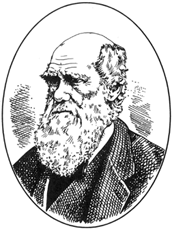Early Changes in Thought
 |
| Figure 38-1 Charles Darwin (1809-1882) laid the foundation for our concepts of evolution. (Illustration by Donna Mariano) |
It was not until the late eighteenth and early nineteenth centuries that views began to change. Buffon (Comte de Georges Louis LeClerc Buffon [1707-17881) suggested that the environment had a molding influence on organisms, and Lamarck (Chevalier de Jean Baptiste Pierre Antoine De Monet Lamarck [1744-1829]), following the same trend of thought, proposed the theory of the inheritance of acquired characteristics. According to Lamarck's theory, organisms respond to their needs by achieving changes, which they then pass on to their progeny.
Progress toward a concept of evolution (that is, of changes occurring and accumulating over the long span of time) did not come without setbacks. Baron Georges Leopold Cretien Frederic Dagobert Cuvier (1769-1832) stood fast against such speculations. Cuvier was a man of superior intellect. His great interest in natural history began in childhood. In1 795 he became assistant professor of comparative anatomy at the Museum National d'Histoire Naturelle. In 1802 he became professor at the Jardin des Plantes. Later, he was given an appointment at the Institut Nationale. Although Cuvier discovered numerous fossils, he interpreted these as evidence of cataclysms followed by new creations rather than of evolution. numerous fossils, he interpreted these as evidence of cataclysms followed by new creations rather than of evolution
Etienne Geoffroy Saint-Hilaire (1772-1844) believed that each species was created for its own special purpose; that nature had only one plan of construction; and that the plan of creation was permanent. He interpreted new species and higher categories as occasional appearances of monsters.




